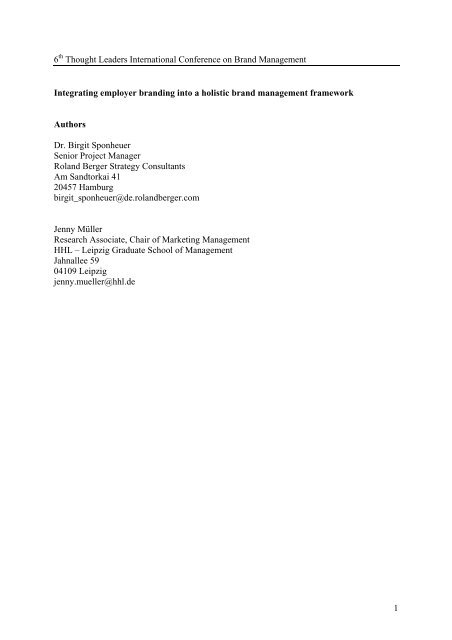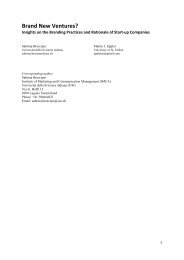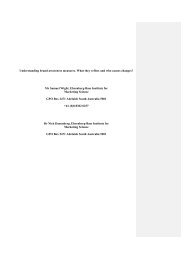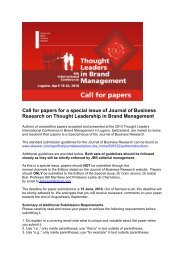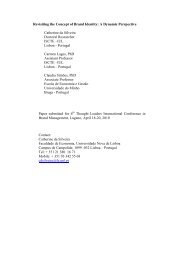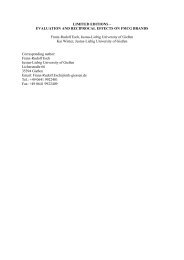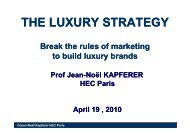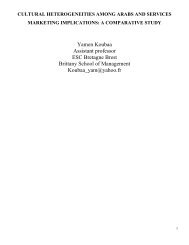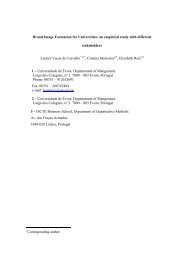Sponheuer, Birgit, Müller, Jenny, Integrating employer branding into
Sponheuer, Birgit, Müller, Jenny, Integrating employer branding into
Sponheuer, Birgit, Müller, Jenny, Integrating employer branding into
You also want an ePaper? Increase the reach of your titles
YUMPU automatically turns print PDFs into web optimized ePapers that Google loves.
6 th Thought Leaders International Conference on Brand Management<br />
<strong>Integrating</strong> <strong>employer</strong> <strong>branding</strong> <strong>into</strong> a holistic brand management framework<br />
Authors<br />
Dr. <strong>Birgit</strong> <strong>Sponheuer</strong><br />
Senior Project Manager<br />
Roland Berger Strategy Consultants<br />
Am Sandtorkai 41<br />
20457 Hamburg<br />
birgit_sponheuer@de.rolandberger.com<br />
<strong>Jenny</strong> <strong>Müller</strong><br />
Research Associate, Chair of Marketing Management<br />
HHL – Leipzig Graduate School of Management<br />
Jahnallee 59<br />
04109 Leipzig<br />
jenny.mueller@hhl.de<br />
1
6 th Thought Leaders International Conference on Brand Management<br />
<strong>Integrating</strong> <strong>employer</strong> <strong>branding</strong> <strong>into</strong> a holistic brand management framework<br />
Abstract<br />
Companies use <strong>employer</strong> <strong>branding</strong> to enhance their position as an attractive <strong>employer</strong>. But<br />
<strong>employer</strong> <strong>branding</strong> is not an isolated HR exercise: It needs to be integrated <strong>into</strong> a company's<br />
broader brand management approach. The interdependencies between different stakeholder<br />
groups – employees, potential employees and customers – mean that careful coordination of<br />
the design and implementation of brand strategies is essential. While each target group's<br />
specific needs and expectations should be addressed by consumer and <strong>employer</strong> <strong>branding</strong> to<br />
maximize the brand's effect, contradictions that threaten the credibility of a brand must be<br />
avoided. Such coordination maximizes impact and minimizes risks. This study attempts to<br />
clarify the relationship between <strong>employer</strong> brand management and consumer-oriented brand<br />
management. It proposes a conceptual framework for a holistic brand management approach<br />
to <strong>employer</strong> brands, and derives implications for companies based on their specific situation.<br />
Keywords:<br />
Employer <strong>branding</strong>; stakeholder; coordination; holistic brand management; self-congruence<br />
hypothesis; person-organization fit<br />
2
1 Introduction<br />
The idea that employees are a key resource for a company's success has received much<br />
empirical and theoretical support (Huselid, 1995; Penrose, 1997; Höllmüller, 2002). Winning<br />
and retaining highly-qualified talent is a core element on the corporate agenda. But while the<br />
demand for high-performing employees is steadily rising in today's knowledge economy,<br />
demographic change and shortcomings in the educational sector mean that fewer and fewer<br />
candidates are available. Indeed, countries like Germany already faces a severe shortage of<br />
specialized workers in crucial areas such as engineering (Esch, Wicke, 2001; Meffert, Giloth,<br />
2002; Statistisches Bundesamt, 2003; High Potentials, 2008/2009). Consequently, companies<br />
are looking for ways to gain a competitive edge in the war for talent. "Employer <strong>branding</strong>" is<br />
one such solution. It is a recent conceptual approach to human resources marketing that<br />
applies the well-understood mechanisms of brand management in the consumer market to the<br />
labor market (Barrow, Mosley 2005; Kirchgeorg, Günther 2006; <strong>Sponheuer</strong>, 2010). But while<br />
<strong>employer</strong> <strong>branding</strong> is targeted to potential and current employees and thus needs to address<br />
their needs, values and expectations in the first place, it is important that companies integrate<br />
<strong>employer</strong> <strong>branding</strong> <strong>into</strong> their overall brand management to ensure that they send a consistent<br />
message to both internal and external audiences. The present study expands on existing<br />
research on the relationship between <strong>employer</strong> and consumer <strong>branding</strong>, developing a holistic<br />
conceptual framework that integrates the two.<br />
2 Problem formulation and definitions<br />
Employer <strong>branding</strong> refers to the targeted planning, management, coordination and controlling<br />
of a brand for the company in its function as <strong>employer</strong>. The <strong>employer</strong> brand can be seen as a<br />
benefit bundle that provides the company (as <strong>employer</strong>) with specific benefit characteristics,<br />
which differentiate the company from other <strong>employer</strong>s in the eyes of employees (<strong>Sponheuer</strong>,<br />
2010). Employer <strong>branding</strong> can thus be characterized as a special aspect of corporate <strong>branding</strong><br />
(Kernstock et al., 2004). The <strong>employer</strong> brand focuses on the labor market and thus on the target<br />
groups of potential, current and former employees, while the corporate brand addresses all<br />
the company's stakeholders equally (Davidson 1999; Demuth 2000; Bierwirth, 2003).<br />
Brands signal specific values and promises that create preferences and desirable behavior in<br />
target groups. The "self-congruence hypothesis" goes some way to explaining how brands<br />
function. It states that individuals tend to choose brands whose perceived value system<br />
reflects most closely their own self-image and thus their own values (Burn 1979, Sirgy 1982).<br />
This connection can be demonstrated empirically not only for the consumer market but also<br />
for the labor market. Here, one speaks of "work value congruence" or "person-organization<br />
fit" (Balmer, Dinnie 1999; Hogg, Terry, 2000). Various studies have shown that applicants<br />
with a good value fit are more interested in a company, accept job offers, fit in quicker, are<br />
more committed and stay with the company longer (Shamir, 1991; Dutton, 1994). A good fit<br />
between the corporate values (as embedded in the <strong>employer</strong> brand) and the employee's own<br />
values is thus essential for the brand to influence the employee's behavior. To maximize the<br />
effectiveness of the <strong>employer</strong> brand – i.e. its impact on current and potential employees – the<br />
<strong>employer</strong> brand strategy thus has to be as closely targeted toward these groups as possible.<br />
At the same time, the literature on brands calls for a high level of consistency in brand<br />
management with regard to the various stakeholder groups (Balmer, 2001; Hatch, Schultz,<br />
2001; van Riel, 2003). As different stakeholder groups may have different, even opposing,<br />
interests, companies must consider carefully which expectations their brand promise is to<br />
3
address. In "identity-based brand management," a distinction is drawn between how internal<br />
target groups view themselves (brand identity) and how external target groups view the brand<br />
(brand image). Both aspects are formed by the messages sent out by the company and the<br />
individual brand-related experiences of individuals (Burmann et al., 2009 (a); Burmann et al.,<br />
2009 (b)). Contradictory signals about a brand can endanger its effectiveness, as they weaken<br />
the clarity of its perception and hence the credibility of the brand. Accordingly, the greatest<br />
possible conformity between brand identity and image is required. This can be achieved<br />
through strict consistency in the internally and externally oriented brand management (Burmann<br />
et al., 2009 (a); Burmann et al., 2009 (b)). Consistency here is taken to mean the integrated,<br />
internally and externally oriented coordination of all the brand characteristics in the<br />
form of an internally and externally consistent combination of individual brand contents<br />
(Meffert, Giloth, 2002).<br />
These considerations have led some researchers to conclude that brand management should be<br />
largely uniform for the different stakeholder groups (Olins, 1989; Fombrun, 1996; Leitch,<br />
1999; Balmer, Greyser, 2002). Yet this could run counter to the goal of targeting the <strong>employer</strong><br />
brand as closely as possible at individual target groups, and so undermine the impact of brand<br />
management. To achieve these two apparently contradictory goals, the brand management in<br />
the consumer and labor markets must be coordinated (van Riel, 2003; Hatch, Schultz, 2001;<br />
Balmer, 2001). Four interdependencies are key here (<strong>Sponheuer</strong>, 2010; Adam, 1997):<br />
• The corporate brand forms an overarching umbrella that influences both consumer and<br />
<strong>employer</strong> <strong>branding</strong><br />
• Employees play a dual role in brand management: They are the target group of corporate<br />
and <strong>employer</strong> <strong>branding</strong>, and at the same time they are brand messengers for consumers and<br />
employees<br />
• The overlapping perceptions and roles of a company's various stakeholder groups make it<br />
impossible to send completely separate brand messages to each of these groups<br />
• Consumer-oriented brand management has an overarching attraction and identification<br />
effect on employees, too.<br />
To achieve the required coordination between the brand management in the consumer and<br />
labor markets, <strong>employer</strong> <strong>branding</strong> cannot remain an isolated HR-discipline, but has to be<br />
embedded in a holistic brand management approach – one that also takes <strong>into</strong> account<br />
consumer brand management. The aim here is to avoid perceptible contradictions in the brand<br />
messages directed toward the various different target groups (Festinger, 1978). At the same<br />
time, the brand messages aimed at the different target groups should strengthen each other<br />
and so support the credibility of the company (Bierwirth, 2003; Barrow, Mosley, 2005). For<br />
example, a positive corporate image makes the company more attractive as an <strong>employer</strong> and<br />
thus makes it easier to attract, retain and motivate employees (Aiman-Smith et al., 2001;<br />
Barrow, Mosley, 2005). Likewise, a positive image as an <strong>employer</strong> – e. g. with regard to<br />
social responsibility – can improve a company's reputation and boost its sales (Grayson,<br />
Hodges, 2004). To achieve this coordination, it is necessary to develop a framework that<br />
captures all the elements that must be taken <strong>into</strong> account in the strategic design and<br />
operational implementation of the <strong>employer</strong> brand.<br />
3 Conceptual framework<br />
Three possible approaches to stakeholder coordination in brand management can be identified<br />
in the literature:<br />
4
1. Prioritization of stakeholders (Mitchell et al.,1997; Kernstock, 2004; Jones, 2005):<br />
Stakeholder groups are rated according to their importance. Brand management is then<br />
targeted toward the needs of the most important group. As almost all companies see their<br />
customers as the key stakeholder group, the result is that <strong>employer</strong> brands are shaped in<br />
line with consumer brands.<br />
2. Design of the brand architecture (Bierwirth, 2003; Kapferer, 2004): This approach assumes<br />
that different stakeholder groups have different relationships with the various hierarchical<br />
levels of the company and brand. Thus customers relate most closely to product brands,<br />
while employees and other stakeholders relate mainly to the corporate brand. This allows<br />
companies to separate out the perceptual interdependencies between the different<br />
stakeholder groups and so reduce the need for coordination. In practice, however, this<br />
approach is problematic: stakeholders generally take a comprehensive view of a company,<br />
so separating out their different perceptions is impractical.<br />
3. Meta-positioning (Klein-Bölting, Gürntke, 2002): The meta-positioning of the corporate<br />
brand is defined in sufficiently broad and abstract terms that it integrates the interests of all<br />
relevant stakeholders. The need for coordination is met by striving to achieve conformity<br />
between the internal and external image on the basis of shared identity dimensions (De<br />
Chernatony, 1999). This approach achieves the required consistency, but at the cost of<br />
brand impact, as the brand's orientation toward specific target groups is relatively weak.<br />
None of these approaches, then, allows the <strong>employer</strong> brand to be oriented sufficiently toward<br />
specific target groups. A number of researchers have investigated the development of an<br />
<strong>employer</strong> brand and <strong>employer</strong> brand management (Moroko, Uncles, 2008; Kirchgeorg,<br />
Lorbeer, 2002; Franke, 2000; Grobe, 2000; Judge, Bretz, 1992). However, a truly holistic<br />
concept is still lacking – one that would encompass all the elements influencing the definition<br />
and implementation of an <strong>employer</strong> brand at the same time as considering consumer-oriented<br />
brand management (Mellor, 1999). This paper attempts to fill this gap with a new conceptual<br />
framework that integrates both <strong>employer</strong> and consumer-oriented <strong>branding</strong>.<br />
Our approach is to extend the previously one-dimensional, consumer-oriented brand management<br />
process to include the internal and the labor-market-oriented perspective. The conceptual<br />
basis underlying the framework is the concept of identity-based brand management.<br />
The core idea in identity-based brand management is to interlink the brand identity (how<br />
internal target groups view themselves) with the brand image (how external target groups<br />
view the brand). An integrated view of the consumer and the labor market thus comprises<br />
three distinct elements: the company itself, the labor market, and the consumer market. For<br />
the company, the brand identity is the key concept for brand management; for the labor and<br />
consumer markets, it is the brand image. Thus the internal (identity) and external (image)<br />
perspectives on the brand are considered in an integrated fashion (Burmann et al. 2009 (a);<br />
Burmann et al. 2009 (b)).<br />
In addition, the brand management process is used as the basis for the conceptual framework.<br />
The revolving process of developing and implementing a brand strategy can be divided <strong>into</strong><br />
five main steps (Meffert, Burmann, 2002):<br />
1. Analysis of target groups and context: the values, expectations and decision-making<br />
processes of target groups; the perceptions of external target groups (image) and internal<br />
target groups (identity); the company's broader contextual situation regarding the business<br />
5
2. Definition of objectives<br />
3. Brand strategy development (brand architecture and positioning)<br />
4. Internal and external implementation (human resources marketing mix, consumer-oriented<br />
operational marketing mix, internal brand management)<br />
5. Brand controlling<br />
Arranging these five steps and their sub-steps according to the three different perspectives –<br />
labor market, company, and consumer market – gives the framework shown in Fig. 1 (<strong>Sponheuer</strong>,<br />
2010). This holistic framework is the first one that comprises all the elements influencing<br />
the definition and implementation of an <strong>employer</strong> brand while considering consumeroriented<br />
brand management at the same time. We have excluded brand controlling to reduce<br />
complexity. Each step builds on and shapes other steps in an iterative process. Some interdependencies<br />
are indicated by arrows, focusing on those relevant for coordination between<br />
<strong>employer</strong> and consumer <strong>branding</strong>. Influencing factors need to be considered when defining<br />
objectives, strategy or implementation measures. Strategic decisions and contextual factors in<br />
return may have an effect on influencing factors one should be aware of in <strong>employer</strong> brand<br />
management (e.g. the effect of labor market image on expectations of current employees).<br />
ANALYSIS<br />
Target groups<br />
Situation/<br />
context<br />
OBJECTIVES<br />
STRATEGY<br />
IMPLEMENTA-<br />
TION<br />
Influence Effect<br />
LABOR MARKET COMPANY CONSUMER MARKET<br />
• Values and expectations<br />
• Decision process<br />
Brand image<br />
Objectives<br />
Employer brand<br />
architecture<br />
Employer brand positioning<br />
HR marketing mix<br />
Fig. 1: Conceptual framework<br />
• Values and expectations<br />
• Decision process<br />
Identity<br />
Interface employee/<br />
external people<br />
Corporate strategy<br />
and current situation<br />
Internal brand<br />
management<br />
• Values and expectations<br />
• Decision process<br />
Brand image<br />
Market and competition Market and competition<br />
Objectives Objectives<br />
Brand architecture<br />
Positioning<br />
• Corporate brand<br />
• Further brands (e.g. product brands, if<br />
applicable)<br />
Marketing mix<br />
Some selected elements of the conceptual framework will be further analyzed in the next<br />
chapter with regard to the need for coordination.<br />
6
4 Assumptions regarding the need for coordination<br />
In identity-based brand management, the company's brand management should ideally be as<br />
consistent as possible for the different stakeholder groups. However, we may assume that the<br />
need for coordination between <strong>employer</strong> and consumer-oriented brand management depends<br />
on differing situational and company specific factors within the proposed framework, and so<br />
will vary from company to company. We can thus develop assumptions as to the conditions<br />
under which coordination is less important. These conditions then allow for the creation of a<br />
more independent <strong>employer</strong> brand in order to be able to position the <strong>employer</strong> brand more<br />
precisely toward the needs of employees, maximizing the brand's effectiveness. In our<br />
understanding, a strong need for coordination means extensive conformity between the<br />
different elements involved in brand management, while a weak need for coordination allows<br />
for differentiation, particularly in the brand architecture and positioning (<strong>Sponheuer</strong>, 2010).<br />
Based on an analysis of the linkages between the different elements in the conceptual framework<br />
shown above, we propose four assumptions about the need for coordination at different<br />
points in the brand management process. We include practical examples taken from literature.<br />
Assumption 1: Where stakeholder groups in the consumer and labor markets have distinct<br />
value profiles, the need for coordination tends to be less<br />
According to the self-congruence hypothesis, the fit between the brand's values and the values<br />
of the target groups determines the effectiveness of the brand. If a company wants to attract a<br />
different type of employee from its customers, conformity between consumer and the <strong>employer</strong><br />
brand will result in an undesirable "selection mechanism" (Schneider, 1987; Meglino et al.,<br />
1989; Aiman-Smith et al., 2001). In this case, differentiating the brand positioning between<br />
the consumer and the <strong>employer</strong> brand can make sense, as it allows to address the values of the<br />
employees in a targeted fashion. In practice, this can be observed in the case of discount<br />
stores that intentionally differentiate between the consumer and the labor market in their price<br />
positioning: Brands are positioned as price-conscious or low for customers, but high salaries<br />
are offered to staff to make the company attractive on the job market (<strong>Sponheuer</strong>, 2010).<br />
Assumption 2: Where a company has a different corporate identity in the consumer and labor<br />
markets, the need for coordination tends to be less<br />
The characteristics ascribed by employees to a company as <strong>employer</strong>, i.e. its corporate identity,<br />
may differ substantially from the characteristics ascribed to it as a provider of products and<br />
services (Pratt, Foreman, 2000; Chernatony, 2002). In this case, differentiating between the<br />
consumer and the <strong>employer</strong> brand does not run the risk of a loss of credibility, as long as a<br />
brand positioning is developed for each market that is relevant, distinct and desirable for the<br />
target groups in question. For example, the pharmaceuticals group Roche uses the value<br />
"passion" in its <strong>employer</strong> brand, stressing the dedication of its staff to their work, but it does<br />
not use this value in its positioning of products and services in the consumer market, as it is<br />
not part of the consumer brand identity (<strong>Sponheuer</strong>, 2010).<br />
Assumption 3: The less the brand perception of external parties is shaped by the behavior of<br />
the company's employees, the less the need for coordination tends to be<br />
As well as a company's products, its employees form a core interface between internal and<br />
external stakeholder groups. The employees play an important role as brand ambassadors,<br />
depending on the amount of contact they have with customers, which in turn depends on the<br />
7
type of business the company is in. Employees are also important multipliers of the <strong>employer</strong><br />
brand (Sutherland et al., 2002). The more employees identify with the values of the company,<br />
the better they can act as its ambassadors. Due to the "person-organization fit" mechanism, an<br />
<strong>employer</strong> brand appeals to a specific target group as employees through the brand values it<br />
projects. This also determines the ability of its employees to live these values and communicate<br />
them externally (Balmer, Dinnie 1999; Hogg, Terry, 2000). In industries based strongly<br />
on services, employees form a crucial interface between the brand and the customers. For<br />
product-driven companies such as L'Oréal, on the other hand, this is less important, as most<br />
staff have no direct contact with customers (Universum Communications, 2005).<br />
Assumption 4: Where a company employs different brands in the consumer and labor<br />
markets, the need for coordination tends to be less<br />
To a degree, the brand architecture allows companies to direct the attention of different<br />
stakeholder groups toward different objects (Bierwirth, 2003). If a company uses several<br />
product brands with distinct positions on the consumer market but focuses on its corporate<br />
brand on the labor market, the positioning of the <strong>employer</strong> brand may differ from those of the<br />
consumer brands (Grout, 2002; Kernstock, 2004). In practice, a company's overarching brand<br />
architecture appears to play a dominant role in shaping the <strong>employer</strong> <strong>branding</strong> strategy. While<br />
companies with strong corporate brands such as RWE, UBS, and BP emphasize consistency<br />
between their <strong>employer</strong> and consumer brands, companies with complex brand portfolios such<br />
as Kraft, L'Oréal and Johnson & Johnson try to develop a more independent <strong>employer</strong> brand<br />
(Universum Communications, 2005).<br />
Summarizing above assumptions, companies must pay particular attention to consumer brand<br />
management when defining and implementing their <strong>employer</strong> <strong>branding</strong> strategies,<br />
coordinating the two. This allows them to maximize the impact of their <strong>employer</strong> brand by<br />
striking the correct balance between consistency and target-group orientation. The recent<br />
attention paid to this topic in academic circles forms a solid basis for this undertaking.<br />
5 Conclusion and management implications<br />
The situation of every company is different. Differences in corporate culture or the<br />
expectations and values of target groups in the labor market, for example, have an impact on<br />
how the <strong>employer</strong> brand is shaped. Companies must coordinate their <strong>employer</strong> brand with the<br />
consumer-oriented brand strategy on the basis of these different situational factors.<br />
The objective of such coordination is to target the different groups in the labor market as<br />
specifically as possible with the <strong>employer</strong> brand, while achieving a harmonious overall brand<br />
management approach for all stakeholder groups. In this study, we first developed a holistic<br />
overall framework, then investigated individual situational factors to see what coordination<br />
was required, and finally derived assumptions regarding the need for coordination. In this way<br />
we have deepened our understanding of identity-based brand management, adding a new<br />
element of cross-stakeholder brand management in which the company's most important<br />
target groups – customers and employees – are addressed equally.<br />
Holistic approaches such as that proposed here are still rare in practice. Most companies<br />
somewhat neglect the issue of targeted coordination. Very often individual factors play a<br />
dominant role, such as the company's brand architecture or, in the case of the service industry,<br />
the close relationship between the company's customers and its staff.<br />
8
In the future, companies themselves can analyze their individual need for coordination in<br />
brand management using the holistic conceptual framework proposed here. This will enable<br />
them to coordinate their <strong>employer</strong> and consumer <strong>branding</strong> in a targeted fashion, boosting the<br />
impact of their <strong>employer</strong> brand and improving the overall effectiveness of their brand<br />
management. Three basic options for positioning the <strong>employer</strong> brands are identified<br />
(<strong>Sponheuer</strong>, 2010):<br />
• If the need for coordination is weak, the <strong>employer</strong> brand can be positioned independently<br />
of the consumer brand, i.e. the <strong>employer</strong> and consumer brands can communicate different<br />
values and benefits to their respective stakeholder groups<br />
• If the need for coordination is somewhat stronger, the <strong>employer</strong> and consumer brands can<br />
be given the same values and benefits. However, these values and benefits can then be<br />
interpreted differently for the different target groups, allowing at least a minimum of<br />
differentiation in the communication toward consumer and labor markets<br />
• If the need for coordination is strong, the <strong>employer</strong> and consumer brands should be<br />
positioned and communicated identically<br />
In the first two options – differentiation either in the positioning or the interpretation of the<br />
brands – it is important that no obvious contradictions arise between messages sent toward the<br />
different target groups. Any such contradictions will undermine the credibility of the brand<br />
management. Those involved in brand management should therefore try to identify a "zone of<br />
tolerance" within which differentiation is possible without being perceived as contradictory<br />
by stakeholder groups. The exact boundaries of this zone of tolerance can be determined by<br />
conducting surveys of target groups, for instance (<strong>Sponheuer</strong>, 2010).<br />
6 Limitations of the study and avenues for future research<br />
Employer <strong>branding</strong> is a relatively new and, from the perspective of strategic brand<br />
management, largely unresearched field. The framework presented in this paper is a first<br />
attempt to define a comprehensive – although perhaps not exhaustive – approach. Given the<br />
complexity of the subject and the many different influencing and company specific factors<br />
involved, it has been necessary to focus our attention on particular areas of interest.<br />
Subsequent research should attempt to incorporate additional elements <strong>into</strong> the model and<br />
provide insights <strong>into</strong> the need for coordination in brand management depending on other<br />
factors. It would also theoretically be possible to extend the framework to include other<br />
relevant stakeholder groups, such as investors. In this way a general model for comprehensive<br />
brand management that embraces all relevant target groups could emerge.<br />
The assumptions presented in this paper were examined purely on a qualitative basis, backed<br />
up with examples from the literature. Future research should re-examine the results of this<br />
study using quantitative methods and looking at a larger number of cases. Such research<br />
should include additional assumptions derived from analyzing the remaining elements in the<br />
conceptual framework presented here (<strong>Sponheuer</strong>, 2010).<br />
The research approach outlined in this paper should thus be seen as an encouragement to<br />
further research. At the same time, it is hoped that it will provide those responsible for<br />
<strong>employer</strong> brands in companies with a framework for action, thus contributing to an<br />
increasingly professional approach to brand management in the labor market.<br />
9
References<br />
Adam D. Planung und Entscheidung. 4th ed. Gabler, Wiesbaden 1997.<br />
Aiman-Smith L. Bauer T. N. Cable D. M. Are you attracted? Do you intend to pursue? A<br />
recruiting policy-capturing study. Journal of Business and Psychology 2001; 16(2): 219-237.<br />
Balmer J. M. T. From the Pentagon: A New Identity Framework. Corporate Reputation<br />
Review 2001; 4 (1): 11-22.<br />
Balmer J. M. T. Dinnie K. Corporate identity and corporate communications: The antidote to<br />
merger madness. Corporate Communications 1999; 4 (4), 182-192.<br />
Balmer J. M. T. Greyser S. A. Managing the Multiple Identities of the Corporation. California<br />
Management Review 2002; 44 (3): 72-86.<br />
Barrow S. Mosley R. The Employer Brand. Chichester 2005.<br />
Bierwirth A. Die Führung der Unternehmensmarke. Frankfurt am Main, Peter Lang, 2003.<br />
Burmann C. Hegner S. Riley N. Towards an identity-based <strong>branding</strong>. Marketing Theory 2009<br />
(b); 9 (1): 113-118.<br />
Burmann C. Jost-Benz M. Riley N. Towards an identity-based brand equity model. Journal of<br />
Business Research 2009 (a); 62 (3): 390-397.<br />
Burmann C. Zeplin S. Building brand commitment: A behavioural approach to internal brand<br />
management. The Journal of Brand Management 2005; 12 (4): 279-300.<br />
Burn R. B. The Self-Concept in Theory, Measurement, Development and Behaviour. London,<br />
Addison-Wesley Longman Ltd, 1979.<br />
Davidson H. Broaden your brandwidth. Marketing Business 1999: 28-29.<br />
De Chernatony L. Living the corporate brand: brand values and brand enactment. Corporate<br />
Reputation Review 2002; 5 (2/3): 114-132.<br />
De Chernatony L. Brand Management through narrowing the gap between brand identity and<br />
brand reputation. Journal of Marketing Management 1999; 15 (1-3): 157-179.<br />
Demuth A. Das strategische Management der Unternehmensmarke. Markenartikel 2000; 1:<br />
14-22.<br />
Dutton J. E. Dukerich J. M. Harquail C. V. Organizational Images and Member Identification.<br />
Administrative Science Quarterly 1994; 39 (2): 239-263.<br />
Esch F.-R. Wicke A. Herausforderungen und Aufgaben des Markenmanagements. In: Esch<br />
F.-R., editor. Modernes Markenmanagement, 3rd ed. Wiesbaden, Gabler, 2001. pp. 3-55.<br />
Festinger L. Theorie der kognitiven Dissonanz. Bern, Stuttgart, Wien, Huber Hans, 1978.<br />
10
Fombrun C. Reputation: Realising Value from the Corporate Image. MA: Boston, 1996.<br />
Franke N. Personalmarketing zur Gewinnung von betriebswirtschaftlichem<br />
Führungsnachwuchs. Marketing ZFP 2000; 22 (1): 75-92.<br />
Grayson D. Hodges A. Corporate Social Opportunity. Sheffield, Greenleaf Pubs, 2004.<br />
Grobe E. Corporate Attractiveness – eine Analyse der Wahrnehmung von<br />
Unternehmensmarken aus Sicht von High Potentials. Arbeitspapier der HHL – Leipzig<br />
Graduate School of Management 2003; 50 Leipzig.<br />
Grout J. How to recruit excellent people. People Management 2002; 8 (9): 44-45.<br />
Hatch M. J. Schultz M. Are the Strategic Stars Aligned for Your Corporate Brand? Harvard<br />
Business Review 2001; 79 (2): 128-134.<br />
High Potentials 2008/2009. In: Kienbaum Consultants International GmbH, editor. URL:<br />
http://www.kienbaum.de/desktopdefault.aspx/tabid-501/649_read-3801/Kienbaum-Studie,<br />
Status: 2009/10/01<br />
Hogg, M. A. Terry, D. J. Social Identity and self-categorization processes in organizational<br />
contexts. Academy of Management Journal 2000; 25 (1), 121-140.<br />
Höllmüller M. Strategische Akquisition hochqualifizierter Nachwuchskräfte. Wiesbaden,<br />
Deutscher Universitäts-Verlag, 2002.<br />
Huselid M. A. The impact of human resource management practices on turnover, productivity<br />
and corporate financial performance. Academy of Management Journal 1995; 38 (3): 635-<br />
672.<br />
Jones R. Finding sources of brand value: Developing a stakeholder model of brand equity.<br />
Journal of Brand Management 2005; 13 (1): 10-32.<br />
Judge T. A. Bretz Jr. R. D. Effects of work values on Job Choice Decisions. Journal of<br />
Applied Psychology 1992; 77 (3): 262.<br />
Leitch S. Motion J. Multiplicity in corporate identity strategy. Corporate Communications<br />
1999; 4 (4): 193-200.<br />
Kapferer J.-N. The new strategic brand management: creating and sustaining brand equity<br />
long term, 3 rd ed. London, Kogan Page, 2004.<br />
Kernstock J. Esch F.-R. Tomczak T. Langner T. Zugang zum Corporate Brand Management.<br />
In: Esch, F.-R. Tomczak T. Kernstock J. Langner T., editors. Corporate Brand Management,<br />
1st ed., Wiesbaden, 2004. pp. 1-52.<br />
11
Kirchgeorg M. Lorbeer A. Anforderungen von High Potentials an Unternehmen - Eine<br />
Analyse auf der Grundlage einer bundesweiten Befragung von High Potentials und<br />
Personalentscheidern. Arbeitspapier der HHL – Leipzig Graduate School of Management<br />
2002; 49 Leipzig.<br />
Kirchgeorg M. Günther E. Employer Brands zur Profilierung im Personalmarkt – Eine<br />
Analyse der Wahrnehmung von Unternehmensmarken auf der Grundlage einer<br />
deutschlandweiten Befragung von High Potentials. Arbeitspapier der HHL – Leipzig<br />
Graduate School of Management 2006; 74 Leipzig.<br />
Klein-Bölting U. Gürntke K. Corporate Branding im Zeitalter fundamentaler<br />
Unternehmenstransformationen. Insights, Mai 2002: 6-22.<br />
Meffert H. Burmann C. Kirchgeorg M. Marketing - Grundlagen marktorientierter<br />
Unternehmensführung. 1th ed. Wiesbaden, Gabler, 2008.<br />
Meffert H. Burmann C. Managementkonzept der identitätsorientierten Markenführung. In:<br />
Meffert H. Burmann C. Koers M., editors. Markenmanagement - Grundfragen der<br />
identitätsorientierten Markenführung, 1. ed. Wiesbaden, Gabler, 2002. pp. 73-97.<br />
Meffert H. Giloth M. Aktuelle markt- und unternehmensbezogene Herausforderungen an die<br />
Markenführung. In: Meffert H. Burmann C. Koers M., editors. Markenmanagement -<br />
Grundfragen der identitätsorientierten Markenführung, 1st ed. Wiesbaden, Gabler, 2002. pp.<br />
73-97.<br />
Meffert H. Identitätsorientierter Ansatz der Markenführung – eine entscheidungsorientierte<br />
Perspektive. Arbeitspapier der Wissenschaftliche Gesellschaft für Marketing und<br />
Unternehmensführung e.V. 2003; 165, Münster.<br />
Mellor V. Delivering brand values through people. Strategic Communication Management<br />
1999; 3 (2): 26-29.<br />
Meglino, B. M. Ravlin E. C. Adkins C. L. A work values approach to corporate culture: A<br />
field test of the value congruence process and its relationship to individual outcomes. Journal<br />
of Applied Psychology 1989; 74 (3): 424-432.<br />
Mitchell R. K. et al. Toward a theory of stakeholder identification and salience: Defining the<br />
principle of who and what really counts. Academy of Management Review 1997; 22 (4): 853-<br />
886.<br />
Moroko L. Uncles M. Characteristics of successful <strong>employer</strong> brands. Journal of Brand<br />
Management 2008; 16 (3):160-175.<br />
Olins W. Corporate Identity: Making Business Strategy Visible Through Design. London,<br />
Thames & Hudson Ltd, 1989.<br />
Pratt M. G. Foreman P. Classifying managerial responses to multiple organizational<br />
Identities. Academy of Management Review 2000; 25 (1): 18-42.<br />
12
Penrose E. T. The theory of the growth of the firm. 3rd ed. Oxford University Press, New<br />
York 1997.<br />
Schneider B. The people make the place. Personnel Psychology 1987; 40 (3): 437-453.<br />
Shamir, B. Meaning, Self and Motivation in Organizations. Organization Studies 1991; 12<br />
(3), 405-424.<br />
Sirgy J. M. Self-concept in Consumer Behavior: a critical review. Journal of Consumer<br />
Research 1982; 9 (3): 287-300.<br />
<strong>Sponheuer</strong> B. Employer Branding als Bestandteil einer ganzheitlichen Markenführung.<br />
Wiesbaden, 2010.<br />
Sutherland M. M. Torricelli D. G. Karg R. F. Employer-of-choice <strong>branding</strong> for knowledge<br />
workers. South African Journal of Business Management 2002; 22 (4): 13-20.<br />
Statistisches Bundesamt. In the spotlight: Population of Germany today and tomorrow,<br />
Wiesbaden, 2003.<br />
Universum Communications. Employer Branding Global Best Practices 2005. Stockholm,<br />
2005.<br />
Turban D. B. Cable D. M. Firm reputation and applicant pool characteristics. Journal of<br />
Organizational Behavior 2003; 24 (6): 733-751.<br />
van Riel C. B. M. The Management of Corporate Communication. In: Balmer J. M. T.<br />
Greyser S. A., editors. Revealing the Corporation. Routledge, London, 2003. pp. 161-170.<br />
13


